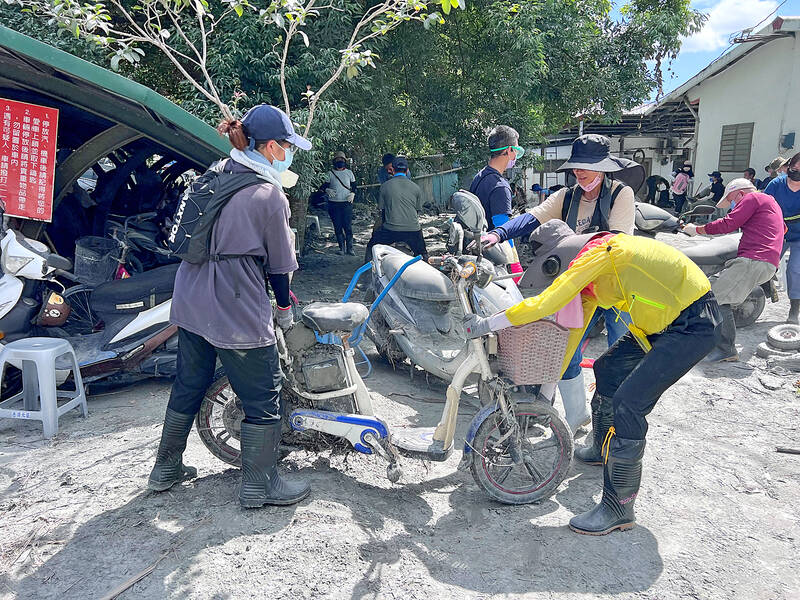Civil groups yesterday called on the government to integrate emotional crisis management into its post-disaster relief procedures, as yesterday marked World Mental Health Day.
World Mental Health Day, initiated by the World Federation for Mental Health, has been observed annually on Oct. 10 since 1992 to promote mental health education.
This year’s theme is “Access to Services: Mental Health in Catastrophes and Emergencies,” the National Education Action Alliance and the Taiwan Federation for Mental Health said in a joint statement.

Photo: CNA
The flooding in Hualien County’s Guangfu Township (光復), caused by a barrier lake in the Mataian River (馬太鞍溪) overflowing during Typhoon Ragasa, was a core issue for mental health, the groups said, citing research and data from health organizations.
The federation’s research found that one-third of disaster victims experience significant psychological effects, while WHO data showed that about 22 percent of those affected by a disaster could develop mental health issues such as anxiety, depression or post-traumatic stress disorder (PTSD).
The groups said that seven schools were closed for nearly two weeks after the barrier lake overflowed.
Students, parents and teachers had to take detours to school and lost school supplies, they said, adding that school grounds were also used as temporary shelters.
In addition to providing counseling, mental health crisis response teams should be immediately set up in schools and communities affected by disasters, the groups said.
Safe spaces and stress relief stations that provide psychological care with the help of counselors, volunteers and community mental health center staff should also be established, they said, adding that it would encourage people to share their concerns and help refer them to group support or individual therapy as needed.
Psychological resilience is not just about telling victims to “be strong”; it is about integrating schools, families and communities into a safety network, federation president Chang Chueh said.
Triage and follow-up systems should be established, while training for teachers and volunteers should be provided, she said.
In other news, Lu Yung-chin (盧永欽), director of the Ministry of Health and Welfare’s Jianan Psychiatric Center Clinical Psychology Department, said that people who suddenly had to face a life-or-death situation or the death of loved ones might develop PTSD, so they should receive special care or counseling in the month after the incident.
Lu cited as an example the case of a six-year-old girl, called Hsiao Yee (小沂) by local media, who was stranded near the roof of a flooded house for two days, saying that although it was heartbreaking to see her burst into tears when rescued, it was a good way to release her stress.
Humans have a natural potential for self-regulation, but if a young child who survived a life-threatening natural disaster becomes speechless or emotionless, then they should be checked for possible PTSD, he said.
Within 30 days after a disaster, survivors should be checked for symptoms of mental stress, such as nightmares, night sweats, palpitations or panic, Lu said, adding that they should be given special care, counseling and companionship to help them move past the trauma.
If the stress is not addressed promptly, it might develop into chronic PTSD, which could affect their ability to function daily or turn into another mental illness, he said, urging people to seek professional medical assistance as early as possible.
Additional reporting by Wu Chun-feng

Taiwanese scientists have engineered plants that can capture about 50 percent more carbon dioxide and produce more than twice as many seeds as unmodified plants, a breakthrough they hope could one day help mitigate global warming and grow more food staples such as rice. If applied to major food crops, the new system could cut carbon emissions and raise yields “without additional equipment or labor costs,” Academia Sinica researcher and lead author the study Lu Kuan-jen (呂冠箴) said. Academia Sinica president James Liao (廖俊智) said that as humans emit 9.6 billion tonnes of carbon dioxide compared with the 220 billion tonnes absorbed

The Taipei Mass Rapid Transit (MRT) Wanda-Zhonghe Line is 81.7 percent complete, with public opening targeted for the end of 2027, New Taipei City Mayor Hou You-yi (侯友宜) said today. Surrounding roads are to be open to the public by the end of next year, Hou said during an inspection of construction progress. The 9.5km line, featuring nine underground stations and one depot, is expected to connect Chiang Kai-shek Memorial Hall Station to Chukuang Station in New Taipei City’s Jhonghe District (中和). All 18 tunnels for the line are complete, while the main structures of the stations and depot are mostly finished, he

Taipei is to implement widespread road closures around Taipei 101 on Friday to make way for large crowds during the Double Ten National Day celebration, the Taipei Department of Transportation said. A four-minute fireworks display is to be launched from the skyscraper, along with a performance by 500 drones flying in formation above the nearby Nanshan A21 site, starting at 10pm. Vehicle restrictions would occur in phases, they said. From 5pm to 9pm, inner lanes of Songshou Road between Taipei City Hall and Taipei 101 are to be closed, with only the outer lanes remaining open. Between 9pm and 9:40pm, the section is

China’s plan to deploy a new hypersonic ballistic missile at a Chinese People’s Liberation Army Rocket Force (PLARF) base near Taiwan likely targets US airbases and ships in the western Pacific, but it would also present new threats to Taiwan, defense experts said. The New York Times — citing a US Department of Defense report from last year on China’s military power — on Monday reported in an article titled “The missiles threatening Taiwan” that China has stockpiled 3,500 missiles, 1.5 times more than four years earlier. Although it is unclear how many of those missiles were targeting Taiwan, the newspaper reported